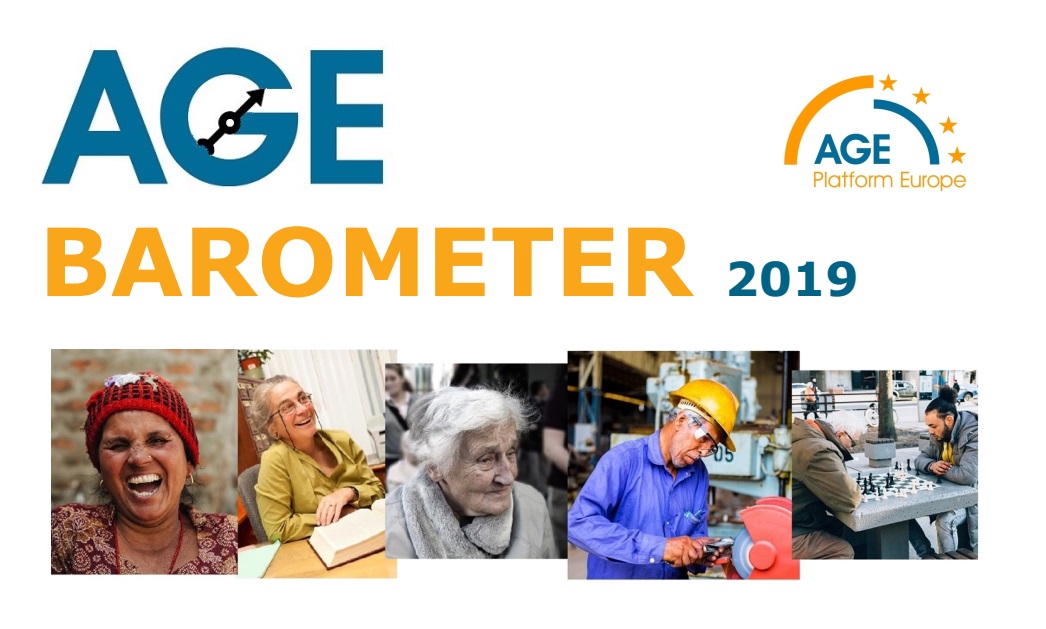PRESS RELEASE
Brussels, 20 June 2019
Launch of AGE Barometer 2019
Persisting age discrimination on the labour market, increasing pressure on informal carers and growing poverty & social exclusion are the daily reality faced by many older people, in particular older women, as AGE members from 10 EU countries report. Today the European Council is meeting to define the EU strategic agenda for the next five years. To contribute to this debate, AGE is launching the first edition of AGE barometer which presents the complex socio-economic realities behind ageing-related policies and their impact on older persons in the EU.
The AGE Barometer aims at monitoring the EU’s and member states’ commitments to the European Pillar of Social Rights, the United Nations Madrid International Plan of Action on Ageing (MIPAA) and Sustainable Development Goals (SDGs). It focusses this year on six key domains related to employment and income of the 50+: gender equality, support to find employment, age-friendly workplaces, work-life balance, fight against poverty, social exclusion and loneliness and adequate pensions.
AGE Barometer draws on a wealth of reliable statistical data and the qualitative assessment by AGE members from a group of countries representative of the diversity among EU member states: Austria, Belgium, Cyprus, France, Germany, Italy, Malta, the Netherlands, Spain, Sweden and the United Kingdom.
‘ AGE Barometer is very useful to compare situations in different EU countries’ , says Anne-Sophie Parent, AGE Secretary-General. ‘ It is striking that the pressure on informal carers has increased in almost all surveyed countries over the past five years and worrying that poverty and social exclusion are recently back on an upwards path.’
The situation is not better for older workers, with little visible efforts made to adapt labour markets and workplaces to Europe’s ageing workforce.
‘Although employment rates of older persons are increasing everywhere, there is still room for improvement for example to help transition from unemployment to work or support older workers with health conditions’ , adds Mrs Parent.
In its quantitative cross-country assessment, AGE Barometer also reveals the inadequacy of some statistics commonly used to describe the situation of older persons: very old people, such as the 75+ are often taken as one block while this age span covers very different situations. Many statistics stop collecting data about persons aged 80+ despite the fact that this is the fastest growing group and all member states need to prepare for the expected sharp increase in older persons needing support and assistance. Some indicators, such as material deprivation, do not properly take account of the increased needs of older persons for essential services such as health and long-term care. Overall, there is a lack of indicators measuring social interaction of older persons.
AGE Barometer will be published every year with rotating thematic focus areas. Next year’s edition will look at health, long-term care, independence and autonomy.
– – – – –
More information:
Note to the editor:
- The European Pillar of Social Rights is a text setting out 20 social rights to access to employment, rights in employment and rights to social protection, and was adopted in 2017 by the European Council, the European Commission and the European Parliament. The rights are non-binding principles, but are a compass for action in the social domain for the EU institutions and member states.
- The UN Madrid International Plan of Action on Ageing (MIPAA) is a political declaration signed by member states of the United Nations (UN) in 2002 showing their commitment to build a society for all ages. In 2017, a Ministerial Conference in Lisbon updated the commitments for the UN European Region through a Ministerial Declaration.
- The Sustainable Development Goals (SDGs) are an intergovernmental set of development goals. All United Nations members have committed to work towards the achievement of all the goals by their target date 2030. The SDGs are made up of 17 goals and 169 indicators. To the difference of their predecessor, the Millennium Development Goals, the SDGs set out social and environmental targets for industrialised countries as well.







